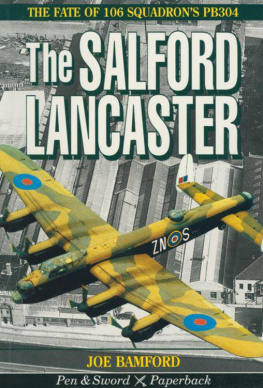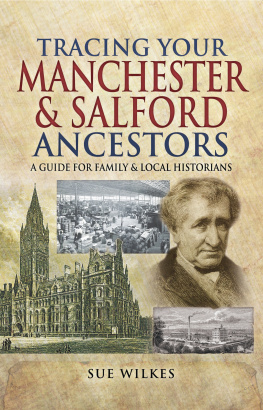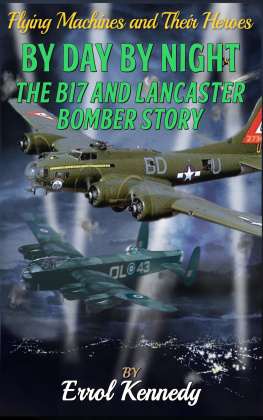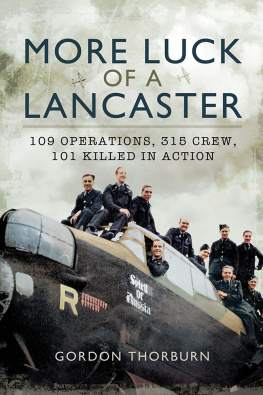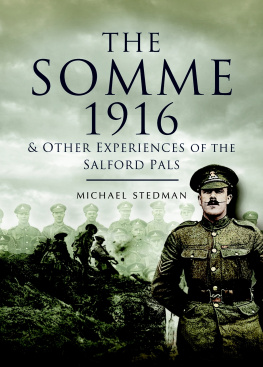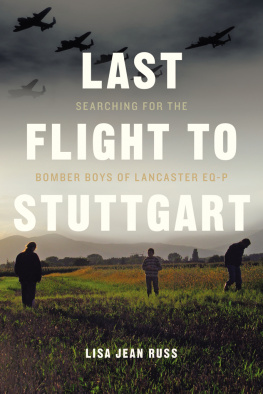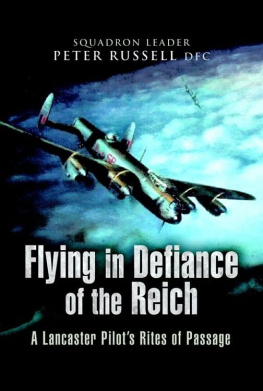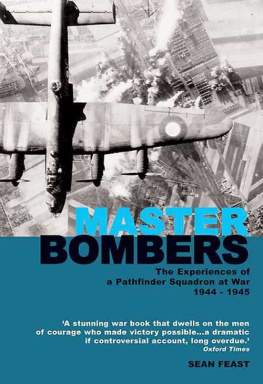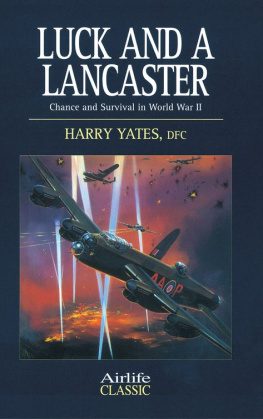THE SALFORD
LANCASTER
ACKNOWLEDGEMENTS
This book was only made possible because of the help and co-operation given by former 106 Squadron personnel and members of the old community in Salford, as well as friends and families of the crew. Particular thanks to Syd Geater, Peter Perry, Irene Barnes, the men of Manchester Aircrew and Bomber Command Associations and members of St. Georges Church. Also Janice, my partner, without whose support it would not have been possible.
Joe Bamford,
October 1996.
THE SALFORD
LANCASTER
by
JOE BAMFORD
First published in Great Britain in 1996 by
Pen & Sword Paperbacks
an imprint of
Pen & Sword Books Ltd,
47 Church Street,
Barnsley,
South Yorkshire S70 2AS
Joe Bamford
A CIP record for this book is available from the British Library
ISBN 0 85052 519 5
All rights reserved. No part of this publication may be reproduced,
in any form or by any means, without permission from
the publishers.
Typeset by Yorkshire Web,
47 Church Street,
Barnsley, South Yorkshire
Printed in Great Britain by
Redwood Books, Trowbridge, Wilts
Contents
During the Second World War 7,377 Avro Lancasters were built and 3,431 of these were lost while flying on operations. On Sunday 30 July, 1944, a Lancaster crashed on the banks of the River Irwell at Salford becoming a statistic along with 246 other bombers recorded as being lost in operational crashes. For the families and friends of the crew it was a day they would never forget. A day when their brothers, husbands and sons were snatched away from them, in an incident that has never been fully explained.
This book is about the seven men who were killed at Salford and the operation from which they were returning when their aircraft crashed. It also covers the period of the crews operations before the accident, and events on 106 Squadron through the summer of 1944. The crew was typical of the airmen who flew in heavy bombers; a team drawn from different social backgrounds and occupations. They were representative of all those who served in Bomber Command and of the 55,000 airmen who died in its service, many of them from overseas.
As none of the crew survived to tell his tale, I have used accounts and anecdotes of those who flew alongside the airmen killed at Salford. They shared a small but memorable part of their lives together and because of common experiences, are able to describe better than most what it was like to fly on a bomber squadron. Many of the aircrew mentioned in these pages flew on the fateful operation and indeed it could have been any one of their aircraft in pieces on the river-bank and their lives lost. From the recollections of eye-witnesses and official archives the events of this tragic day in Salfords history are told. I explain how a small friendly community coped with a disaster which affected a number of local people for the rest of their lives and is remembered fifty years later.
My earliest memories of this incident date back to the days when as a young boy, I and my father would walk across the ground behind my aunt and uncles home which stood on Langley Road, near the former factory of Universal Metal Products, onto the banks of the Irwell, from where there is a wonderful view of the Manchester skyline. We used to stand and talk and he often reminisced about things that had happened during the war and significant amongst these memories was the time an aircraft had attempted to make an emergency landing on the playing fields. The aircraft had crashed on its final approach and what remained of the crash site was visible in the form of a large crater, partly filled in but still noticeable. The hole was by then shallow and its shape irregular, the earth having had fifteen or more years to recover from the impact. That crater was the only evidence of the tragedy but today it has disappeared and only memories remain.
My father was in the ARP and on duty until the early hours of the morning of Sunday 30 July, 1944, the day that the bomber crashed. Like so many others he was still in bed, enjoying a lie-in on a Bank Holiday week-end, whereas my grandmother, Lucy Bamford, was downstairs sorting out some washing in the back room. She was badly injured by flying glass and was taken immediately to Salford Royal Hospital where she died two weeks later.
Family gossip about the war and the occasional mention of the air crash may have sparked off my earliest interest in aviation as the Second World War was still a powerful influence during my formative years in the mid-fifties. During the 50s and 60s the war was still a relatively recent event and there was a feeling that we had missed out on the action. Magazines such as The Air Ace Picture Library portrayed heroic deeds by airman, with such titles as Bombers Moon and Born To Fly, glorifying air combat and war itself, and these publications probably influenced a whole generation of young men.
By the time I was 14 years old, I had already decided to join the Royal Air Force but my first application for an apprenticeship failed and I was told to re-apply on my seventeenth birthday. My interest in aviation was maintained by frequent visits to Manchester Airport, where I witnessed many changes taking place, as jets replaced older piston engined aircraft like the DC7 and Constellation. One day while I was clearing out a drawer at home, I discovered a fragment of metal. It was a piece of alloy roughly two inches square with a rivet hole in it. Clearly visible were marks to suggest that at some point it had been subjected to intense heat. My father told me that it was a fragment that had blown through his bedroom window when the Lancaster had crashed, and was almost certainly a piece of the aircraft. Having this small fragment in my possession made me more determined to find out as much as I could about the Salford Lancaster.
During my RAF training at Swinderby I visited RAF Scampton for an air experience flight in an Andover. After the flight I was taken around a Lancaster which was sitting by the main gate. It was an early B1 and had the code letters of 83 Squadron on its fuselage: OL- Q for Queenie. The bomber had also flown for part of its operational life with 467 Squadron and previously worn the markings PO S for Sugar.
With other trainees I stared at the black giant that towered above us and I do not think there was one amongst us who failed to be impressed by its size and design. On the nose beneath the pilots window, tiny bombs had been painted to indicate the number of operations the Lancaster had flown. Altogether there were 137 of them and although some doubt was cast as to whether it had flown on so many operations, this has now been confirmed. Today Lancaster R 5868 currently wears the markings of 467 Squadron, having been installed in The Royal Air Force Museum at Hendon for many years, where it takes pride of place amongst many other fine exhibits.
The Lancaster that crashed at Salford also bore the letter S for Sugar, but the only remaining piece of that aircraft is the small fragment which was blown through my fathers window. When it crashed, Lancaster serial number PB 304 was carrying 9,000 lbs of bombs which had been destined for German positions in Normandy before the crew were ordered to abort the operation and return to base. The subsequent explosion was heard eight miles away and widespread damage was reported in all the surrounding areas of Swinton, Pendlebury and Salford.

